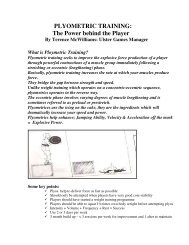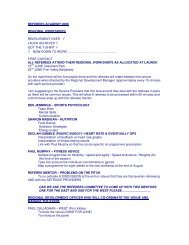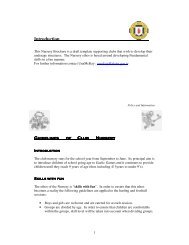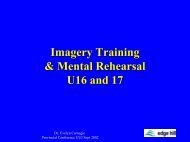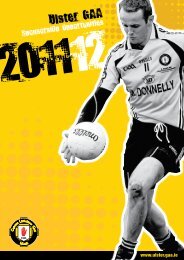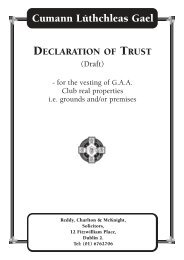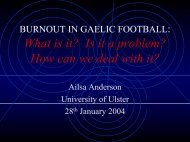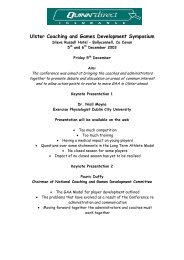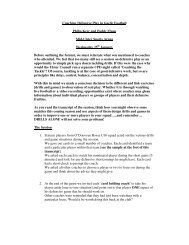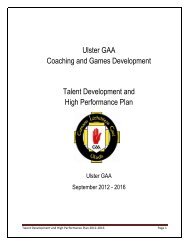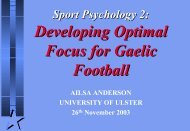Club Manual - Ulster GAA
Club Manual - Ulster GAA
Club Manual - Ulster GAA
You also want an ePaper? Increase the reach of your titles
YUMPU automatically turns print PDFs into web optimized ePapers that Google loves.
• 4.5m approx (15ft) apart.<br />
• Under-14 and up – Full size<br />
Goalnets<br />
Rules of Specification: Official Guide<br />
(iii) Goalnets shall be securely fixed to the back of the crossbar and the back of each goalpost. The roof of<br />
the net shall be supported for a horizontal distance of not less than 900mm, at crossbar height, by a<br />
metal net support fixed to the back of the goalposts. The mesh of the net shall have a diagonal length<br />
not exceeding 150mm for football and 50mm for hurling.<br />
Backdrop to Goals<br />
• Goalposts should NOT be located on the horizon. Where this is not possible posts should be marked to<br />
help differentiate posts from a clear or white sky<br />
• Vegetation surrounding a pitch and behind goals especially improves visibility for participants and<br />
spectators alike. Vegetation can also reduce noise emissions from playing areas to surrounding areas.<br />
• Avoid locating goalposts in front of club facilities.<br />
• Ball stop nets should be located behind goalposts Such nets should not impede the view of spectators.<br />
• Floodlighting should not be located behind goalposts.<br />
8. Guidelines and Recommendations for Floodlighting<br />
<strong>GAA</strong> Policy Objective: To support the provision of floodlighting at <strong>GAA</strong> grounds where this will<br />
increase opportunities and participation<br />
Floodlighting is now an integral part of many <strong>GAA</strong> facilities, particularly all-weather playing fields and practice areas.<br />
Floodlighting and the intensification of use it can bring can, however, be intrusive in some locations. This can be an<br />
issue in both urban and rural areas.<br />
Any <strong>Club</strong> currently considering options for development, looking at their present and future training/coaching and<br />
playing requirements should explore the possibility of erecting Floodlighting.<br />
<strong>Club</strong>s considering the installation of Floodlighting for either training or playing purposes should remember that such<br />
schemes are not for the amateur but should be designed, installed by qualified lighting specialists.<br />
Prior to planning, the club should ask themselves the following questions.<br />
What will the club use the Floodlit area for?<br />
A. Physical Training<br />
B. Ball Work, including mini games<br />
C. Competitive Games<br />
• Design and layout of floodlights should be implemented by a competent lighting supplier and or an electrical<br />
and mechanical engineer.<br />
• <strong>Club</strong>s should ensure that playing surfaces where floodlights are to be provided will have sufficient capacity to<br />
accommodate extra practice sessions and games including the provision of ancillary facilities such as changing<br />
rooms.<br />
• Fast action small playing objects and long viewing distances (Hurling, Rounders and Camogie) require higher<br />
lighting levels than larger playing objects and closer viewing distances (Gaelic football).<br />
• Floodlighting columns must be located so as to minimize obstruction to on site spectator or television viewing<br />
where appropriate. Galvanized steel masts (Numbers will vary depending on height and distance from playing<br />
area) should be positioned on each side of the field and for safety reasons located a distance of at least 5m from<br />
the sideline.<br />
• The height of floodlight columns will influence the evenness of the light falling on the pitch, how many lights are<br />
required and what lux levels (the illumination level).<br />
• The lighting type will influence lux levels on the pitch, level of power required to run the lights and the level of<br />
maintenance required.<br />
• Locating pitches close together creates the possibility of one column lighting pitches in multiply directions.<br />
Lighting should be provided in such a way that it is capable of being redirected where this is appropriate and<br />
should be designed to be of optimum efficiency to minimize wasted light and associated financial costs.<br />
• The size and use of the pitch will have a direct influence on the design of floodlighting.<br />
• The target for illumination should be 50 Lux with a uniformity of 1:3 where the lights are used for training<br />
purposes only (Uniformity level is the difference between the bright spots and those not so bright).<br />
• If the lights are for playing purposes, the recommended minimum lighting level for Gaelic Football is 250 Lux<br />
and Hurling 500 Lux. For competitive games at County and Provincial Grounds where TV cameras will be used<br />
the lighting should be of the highest quality therefore 1000 Lux is recommended at least. In grounds such as<br />
Pairc Ui Rinn, Parnell Park and Austin Stack Park where 1000 Lux has been achieved the lights are mounted at a<br />
height of 30 meters.<br />
130<br />
131



